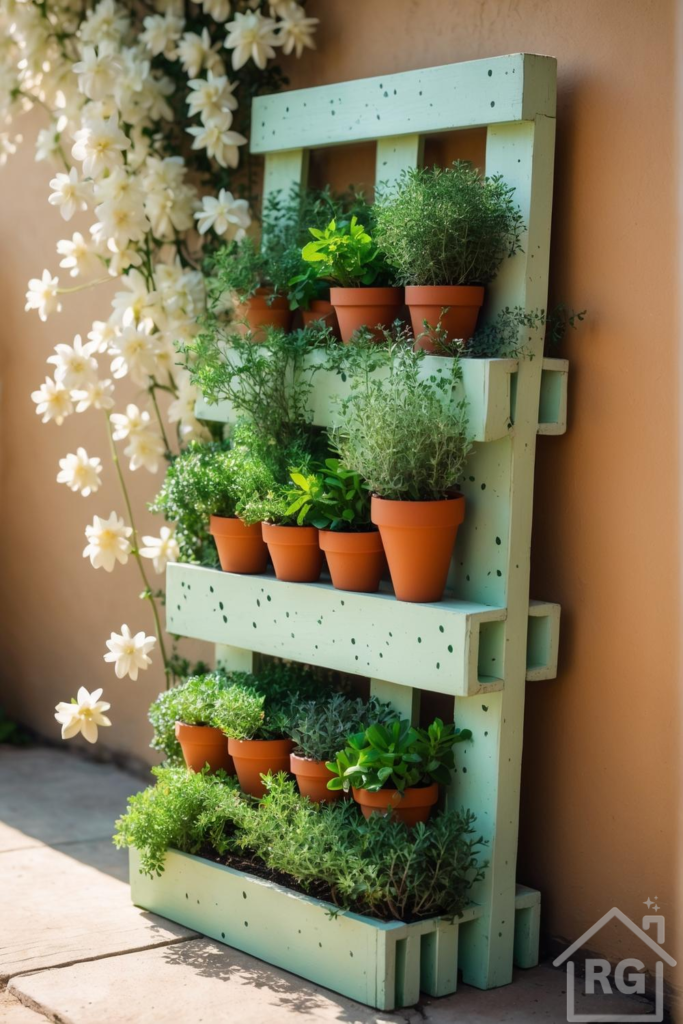
In today’s world, where outdoor living spaces are often at a premium, especially in urban environments, maximizing every square inch becomes an art form. A vertical garden is not just a fleeting trend; it’s a brilliant, space-saving solution for bringing lush greenery, vibrant colors, and even fresh herbs into compact areas.
Imagine transforming your balcony, small patio, or narrow side yard into a verdant retreat. This comprehensive guide will walk you through how to create your very own charming DIY pallet vertical garden, focusing on practical advice, essential material choices, and smart design considerations.
The Allure of Vertical Gardening
Vertical gardens offer a multitude of advantages, making them an increasingly popular choice for urban dwellers and gardening enthusiasts alike:
- Space-Saving Solution: They free up valuable floor space, making them ideal for small balconies, patios, or even indoor areas.
- Aesthetic Appeal: Transform a plain wall into a living work of art, adding visual interest, texture, and a sense of depth to your outdoor area.
- Environmental Benefits: They can contribute to improved air quality, help reduce ambient temperatures, and even offer a degree of sound insulation.
- Fresh Produce at Your Fingertips: For culinary enthusiasts, a vertical herb garden means fresh ingredients are always within arm’s reach, enhancing your cooking with homegrown flavors.
Building Your Pallet Vertical Garden: Key Elements
1. The DIY Pallet Planter: Your Green Canvas
Choosing and Preparing Your Pallet
The foundation of this vertical garden is a repurposed wooden pallet. Not all pallets are created equal, so choose wisely. Look for pallets stamped with “HT” (Heat Treated), which indicates they were treated with heat to prevent pests, rather than harmful chemicals (avoid “MB” for Methyl Bromide). Always inspect the pallet for structural integrity – ensure there are no major cracks, rot, or excessive splintering.
- Cleaning: Give your pallet a thorough cleaning with a stiff brush and soapy water. Rinse well and let it dry completely in the sun.
- Sanding: Lightly sand any rough edges or surfaces to prevent splinters and prepare the wood for paint or sealant.
- Painting: Consider a beautiful, soft sage green, pale celadon, or another calming, natural hue. This color choice provides a serene base that allows the vibrant greens of your plants and the warm tones of terracotta pots to truly pop. Use an exterior-grade paint that is weather-resistant and durable. You might opt for a chalk paint for a rustic, distressed look, or a satin finish for a cleaner appearance. Apply at least two coats for full coverage and protection.
Constructing the Planter Shelves
To hold your pots or directly plant, you’ll need to create shelves or pockets within the pallet’s structure. Here are several effective ways to do this:
- Simple Wooden Shelves: Cut pieces of wood (e.g., 1x4s or 2x4s) to fit horizontally between the pallet’s vertical slats. Secure them firmly with exterior-grade screws or nails to create flat, sturdy surfaces for your pots. Ensure they are level and strong enough to bear the weight of potted plants, especially after watering.
- Fabric Pockets: For a lighter and more flexible alternative, you can staple heavy-duty landscaping fabric or burlap to create pockets between the slats. This method is excellent for direct planting of herbs or for holding smaller pots.
- Bottom Planter Box: Consider adding a larger planter box at the very bottom of the pallet. This can be constructed by adding a solid base and sides to the lowest section, creating a deeper trough suitable for larger plants or a collection of smaller ones. If planting directly, ensure adequate drainage holes are drilled.
Securing Your Vertical Garden
Depending on its size and weight, you may need to secure your pallet garden to a wall for stability, especially if it’s tall or located in a windy area. Use sturdy L-brackets or heavy-duty anchors appropriate for your specific wall material (e.g., stucco, brick, wood siding). Always prioritize safety to prevent tipping and ensure the structure is secure.
2. Plant Selection: Bringing Life to Your Garden
The true beauty of any vertical garden comes from its diverse collection of plants. When selecting what to grow, consider their light requirements, mature size, and water needs to ensure they thrive in their new vertical home.
Herbs and Small Edibles
Herbs are an excellent choice for vertical gardens due to their compact size and frequent use in cooking. Here are some popular options to consider:
- Thyme: A low-growing, fragrant herb that is relatively drought-tolerant once established.
- Oregano: Similar to thyme, with a slightly more upright growth habit and robust flavor.
- Rosemary: While some varieties can grow large, dwarf types are perfectly suited for pots in a vertical garden. Ensure good drainage.
- Mint: Best kept in its own pot as it can be invasive. Many delightful varieties are available.
- Chives: Easy to grow, offering a mild onion flavor.
- Parsley: Both flat-leaf and curly varieties thrive in pots and are kitchen staples.
- Basil: Loves sun and warmth, requiring consistent moisture to flourish.
- Small Edibles: Don’t stop at herbs! Consider compact varieties of lettuce, spinach, or even strawberries for a truly productive vertical garden.
Succulents and Trailing Plants
For textural variety and lower maintenance, incorporate succulents or plants with a succulent-like appearance. They require less frequent watering and add unique forms. Trailing plants, such as sedum, ivy, or string of pearls, can soften the edges of your pallet and create a beautiful cascading effect, adding dynamic visual interest.
Flowering Vines for a Romantic Touch
To add a touch of romance and softness to your vertical garden setup, consider incorporating flowering vines on an adjacent wall or structure. These can create a beautiful backdrop or complementary display. Options include:
- Jasmine: Known for its highly fragrant, beautiful white flowers. Requires a trellis or other support to climb.
- Clematis: Offers many varieties with stunning blooms in various colors. Some are vigorous climbers that can quickly cover a space.
- Climbing Roses: For a more substantial and classic floral display, though they typically require more space and dedicated care.
Ensure your chosen vine has adequate support, whether it’s a small trellis attached to the wall, wires for it to cling to, or a nearby arbor.
Pots and Soil
Terracotta pots are an excellent choice for this garden style. Their warm, earthy tone beautifully complements the painted pallet and the lush greens of the plants. Terracotta is also porous, which helps with drainage and aeration – a significant benefit for many herbs and succulents. Always ensure all pots have adequate drainage holes.
For soil, use a high-quality potting mix that drains well, especially formulated for containers. You might consider specific mixes for herbs or succulents if you’re growing a large quantity of those.
3. The Backdrop and Grounding: Setting the Scene
The Warm Wall
The wall behind your vertical garden plays a significant role in the overall ambiance. A warm sandy beige, muted terracotta, or even a soft cream tone can provide a beautiful contrast to the cool greens of your plants, creating a Mediterranean or rustic feel. If your wall is a different color, consider painting a section of it or adding a large outdoor canvas in a similar warm hue to achieve this inviting effect.
The Grounding Element: Concrete Pavers
A clean, neutral base helps to ground the entire setup. Light concrete pavers offer a practical, durable surface that is easy to maintain. If you don’t have pavers, consider defining the space with a small section of gravel, pea pebbles, or even a durable outdoor rug in a neutral tone.
Creating Ambiance and Flow
Beyond the core elements, thoughtful arrangement and additional touches can elevate your vertical garden space, making it truly special:
- Arrangement: Place taller plants or those needing more sun at the top. Group plants with similar water and light needs together. Consider trailing plants for the lower shelves to spill over. Vary the textures and shades of green for maximum visual interest.
- Lighting: Adding subtle lighting can transform your vertical garden into a magical display after dusk. String lights draped around the pallet or along the wall, or small solar-powered spotlights illuminating key plants, can create a warm, inviting glow.
- Additional Decor: A small garden gnome, a decorative birdhouse, or a rustic watering can placed nearby can add personality without cluttering the space. Remember to keep decor minimal to let the plants be the true stars of your display.
Material Choices for Durability and Longevity
Since your vertical garden will be exposed to the elements, choosing durable materials is paramount to ensure its longevity and beauty:
- Wood Treatment: Beyond painting, consider applying a clear outdoor sealant or varnish to your pallet to further protect it from moisture, UV rays, and rot. Reapply every few years as needed.
- Pots: While terracotta is aesthetically pleasing, it can be prone to cracking in freezing temperatures if left outdoors. If you live in a cold climate, consider bringing pots indoors during winter or using frost-resistant alternatives like glazed ceramic or durable plastic (though plastic may not offer the same rustic aesthetic).
- Fasteners: Always use exterior-grade screws, nails, and hardware that are rust-resistant to prevent unsightly stains and ensure structural integrity.
DIY Tips for Success
To ensure your DIY pallet vertical garden flourishes, keep these practical tips in mind:
- Watering: Vertical gardens tend to dry out faster than traditional garden beds. Consider installing a simple drip irrigation system for consistent watering, or be prepared to water frequently, especially during hot, dry periods. Always water from the top down to allow moisture to trickle to lower plants.
- Soil Quality: Use a high-quality potting mix that offers excellent drainage and aeration. You might amend it with perlite or vermiculite for even better performance, especially for herbs and succulents.
- Fertilization: Plants in containers deplete nutrients more quickly. Feed your plants with a balanced liquid fertilizer every few weeks during the active growing season to support healthy growth.
- Pest Management: Regularly inspect your plants for any signs of pests or diseases. Addressing issues early with organic pest control methods can prevent larger infestations.
- Sunlight Assessment: Before committing to a spot, observe the sunlight patterns in your chosen location throughout the day. This crucial step will help you select plants that will truly thrive in the available light conditions.
Maintenance for a Thriving Garden
Regular care will ensure your vertical garden remains a vibrant and productive feature for years to come:
- Pruning and Harvesting: Regularly prune herbs to encourage bushier growth and harvest them frequently for culinary use. Promptly remove any dead or yellowing leaves to maintain plant health and appearance.
- Repotting: As plants mature, they may become root-bound. Repot them into slightly larger containers or divide them if necessary to give their roots more space.
- Seasonal Adjustments: In colder climates, be prepared to bring tender herbs and plants indoors for winter or protect them with frost cloths to ensure their survival.
- Wood Care: Periodically check the pallet for signs of wear, rot, or fading. Touch up paint or reapply sealant as needed to protect the wood and maintain its appearance.
By following these guidelines, you can transform a simple pallet into a stunning and productive vertical garden, creating a personalized green space that truly enhances your outdoor living area. Enjoy the rewarding process of bringing your vision to life and revel in the beauty and bounty of your very own vertical garden!
